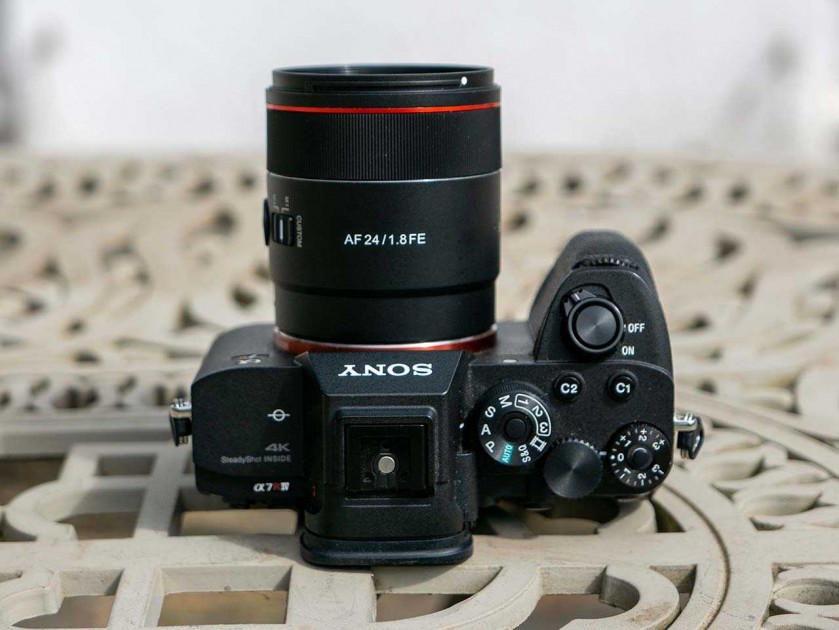Introduction
The Sony FE 24mm F2.8 G is a wide-angle prime lens for Sony Alpha full-frame and APS-C E-mount mirrorless cameras, where it provides a 36mm equivalent focal length.
This new lens boasts a premium weather-sealed construction, a physical aperture ring that can be de-clicked, and a focus hold button.
The 24mm F2.8 for Sony was launched in March 2021 alongside the FE 40mm F2.5 G and FE 50mm F2.5 G lenses.
It features 8 elements in 7 groups, with one Extra-low dispersion element to reduce chromatic aberrations and color fringing and three aspherical lenses which help to control distortion and spherical aberrations.
There’s a Fluorine-coated front element that makes the lens easier to clean by cutting down on dust, moisture, and fingerprints.
This lens boasts a dust- and splash-proof structure and has a minimum focusing distance of 24cm with a maximum magnification of 0.13x when auto-focusing.
It has a rounded 7-blade diaphragm which creates an attractive blur to out-of-focus areas of the image and an internal focusing mechanism which means the lens barrel doesn’t move.
There is a XD Linear Motor AF system with two separate focusing motors for fast, quiet and precise auto-focusing, while the focusing ring provides fine manual focus control.
A traditional aperture ring runs from f/2.8 to f/22 in third-stop increments with an Auto setting also available for camera-based aperture selection.
The Sony FE 24mm F2.8 G lens is available now priced at £630 / $598 in the UK and USA, respectively.
Ease of Use

Weighing in at 162g, the all-metal bodied Sony FE 24mm F2.8 G is very light for such a premium full-frame lens.
It’s substantially lighter than its two main rivals, the Tamron 24mm F/2.8 Di III OSD M1:2 which at 215g is 53g heavier than this new Sony alternative, and the Sigma 24mm F3.5 DG DN which weighs in at 230g.
On the other hand, it is notably more expensive than its main rivals, especially in the UK.
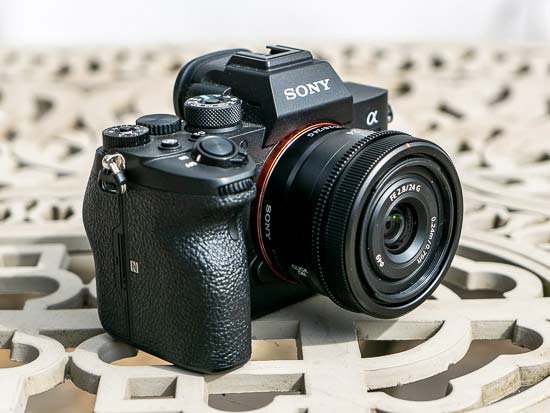
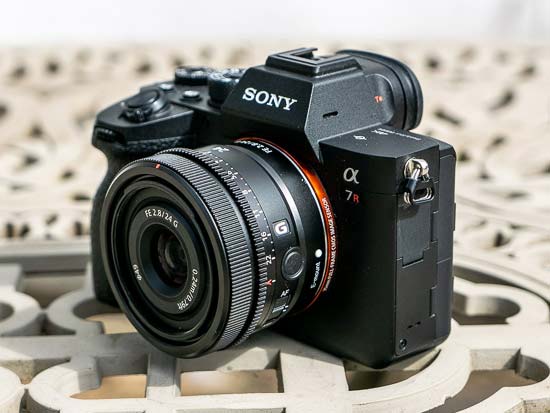
Its overall size and weight is well-suited to a camera like the Sony A7R IV that we tested it with, as shown in the product photos. Even with the supplied hood attached, it is still very discrete.
It measures 68mm x 45mm, making it similarly in size to the Sigma 24mm F3.5 DG DN which measures 64mm x 50.8mm, and much shorter than the Tamron 24mm F2.8 for Sony, which measures 64mm x 73mm.
Build quality is excellent, far exceeding what you might expect from a mid-range prime lens, although it’s not quite as good as the superlative Sigma 24mm F3.5 DG DN.
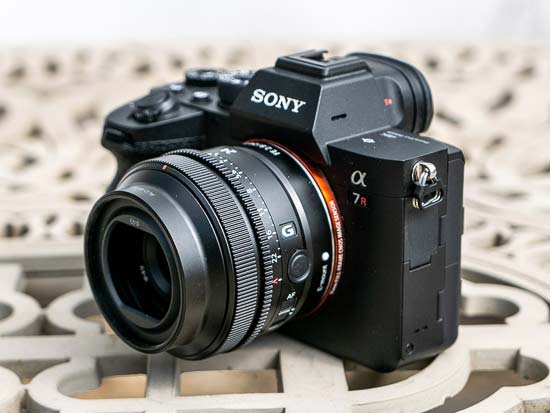
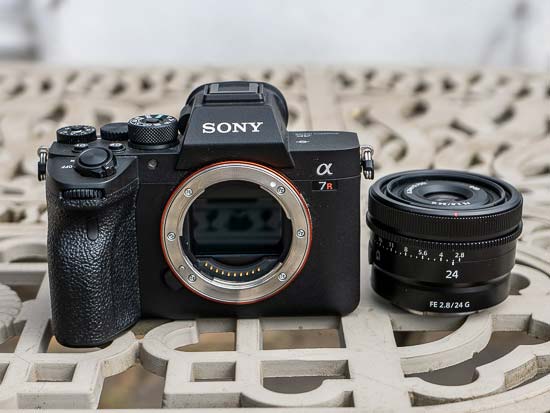
It incorporates a metal mount and lens barrel with metal focus and aperture rings – even the lens hood is metal (all made from aluminium). The focal length and aperture markings are engraved rather than painted on.
It also boasts a dust- and moisture-sealed design to support shooting in more inclement conditions.
The Sony FE 24mm F2.8 G lens accepts 49mm filters via metal threads on the front of the lens.
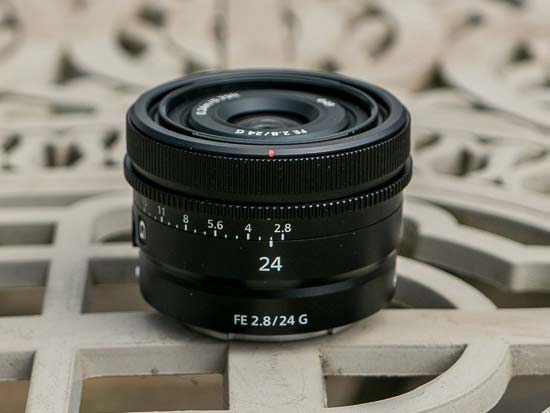
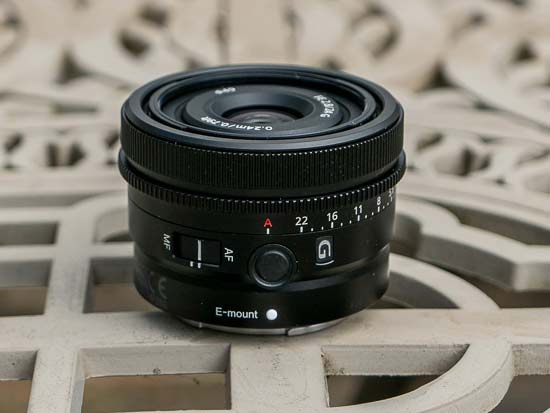
The lens doesn’t feature built-in optical image stabilisation, relying instead on the camera body’s stabilisation system.
The Sony FE 24mm F2.8 G lens has a rather narrow, ridged motor-assisted focus ring that is very nicely damped. Manual focusing is possible by using the focus mode switch to toggle between AF and MF.
As the the focus ring is not mechanically coupled, there are no hard stops at either end of the range, making it a little more difficult to set focus at infinity. Polariser users should be pleased that the 49mm filter thread doesn’t rotate on focus.
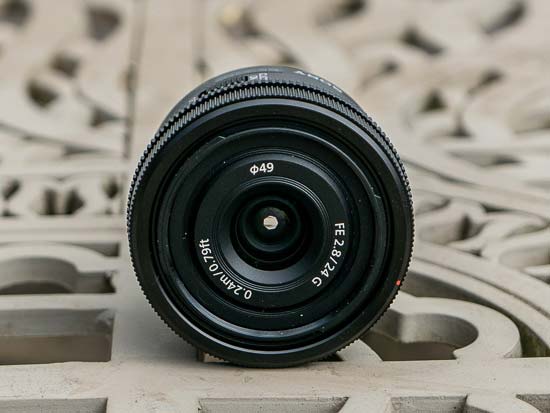
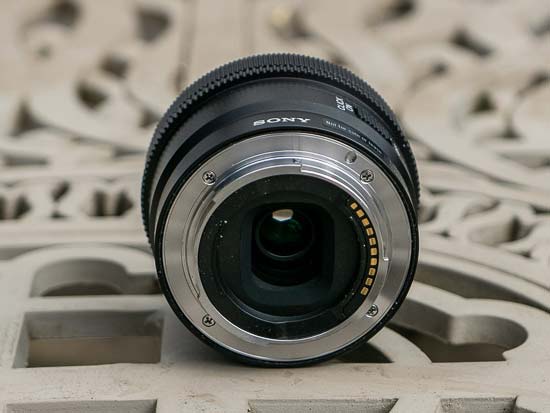
The manual focusing ring is positioned very close to the end of the lens, but the recessed, tapered design of the well-thought-out lens hood means that it doesn’t interfere with the operation of the MF ring when it is fitted.
The Sony FE 24mm F2.8 G lens utilises a XD Linear Motor system that uses two separate focusing motors which produces silent, smooth amd very fast auto-focusing, making it well-suited to shooting both stills and video, with the overall lens length remaining constant during focusing.
When it comes to auto-focusing, it proved to be a very quick performer on the Sony A7R IV camera that we tested it with.
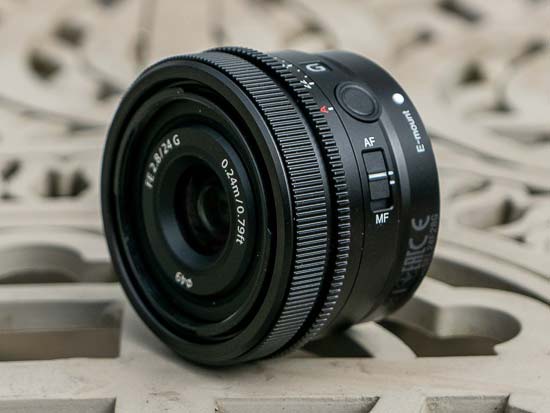
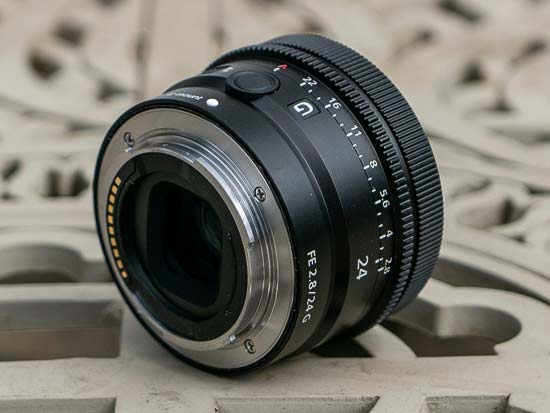
It’s much faster and quieter than the Tamron 28mm F2.8 for Sony lens, which we criticised in our review as being “fairly slow and quite noisy”, and is also marginally faster and quieter than the Sigma 24mm F3.5 DG DN.
We didn’t experience any “hunting”, either in good or bad light, with the lens accurately focusing all of the time.
Sony’s near flawless Eye AF works perfectly with this lens, quickly locking onto and tracking the subject’s eye despite the wide-angle view, and as you’d expect, it fully supports Sony’s DMF and AF+MF shooting modes.
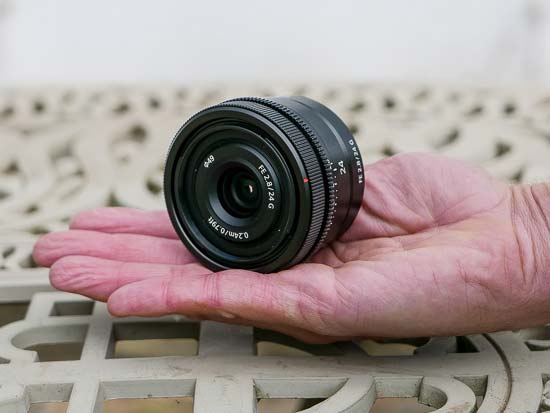
The Sony FE 24mm F2.8 G lens features an aperture ring that has 1/3EV stops ranging from f/2.8 to f/22 and an Auto setting if you prefer to set the aperture via the camera body.
There’s also a Click switch on the lens barrel that lets you de-click it for silent operation during movie recording, something that the Sigma 24mm F3.5 DG DN notably lacks.
Sony have even found room for a small, configurable focus hold button which as the name suggests locks the focus at the current setting.
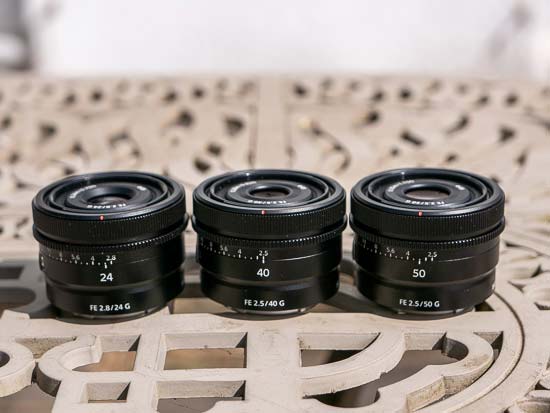
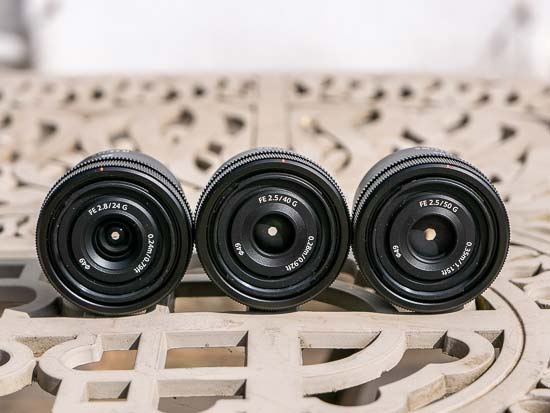
Focal Range
The 24mm focal length provides an angle of view of 84 degrees on a 35mm full-frame camera.
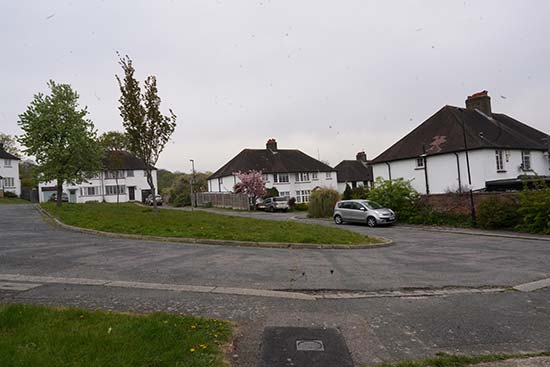
Chromatic Aberrations
Chromatic aberrations, typically seen as blue or purple fringes along contrasty edges, were somewhat apparent in our test shots, appearing in very high contrast areas. The examples below show the worst-case scenario.
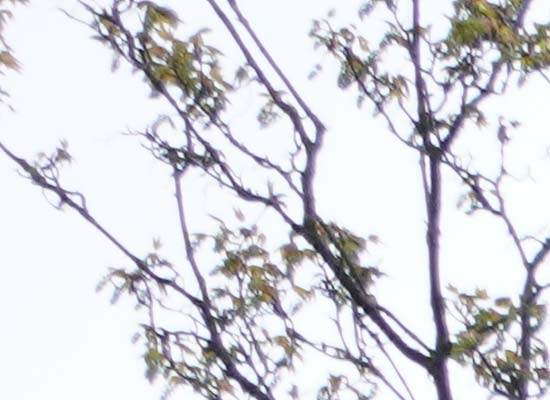
Vignetting
With the lens set to its maximum aperture of f/2.8, there is obvious light fall-off in the corners, requiring you to stop down by at least 3 f-stops to completely prevent it.

Distortion
There’s not much barrel distortion evident in JPG files – the Sony Alpha A7R IV automatically and successfully applies corrections to the JPG files – but it’s a completely different story for RAW files, which exhibit massive amounts of barrel distortion that takes time and effort to correct in post-processing.

JPEG
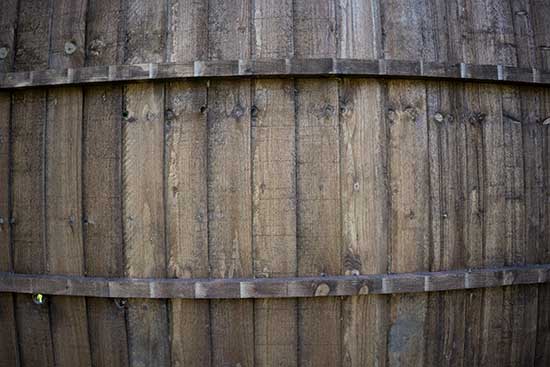
RAW
Sunstars and Flare
The Sony FE 24mm F2.8 G is capable of producing nice sunstars when stopped-down to f/16 and f/22, as shown below.
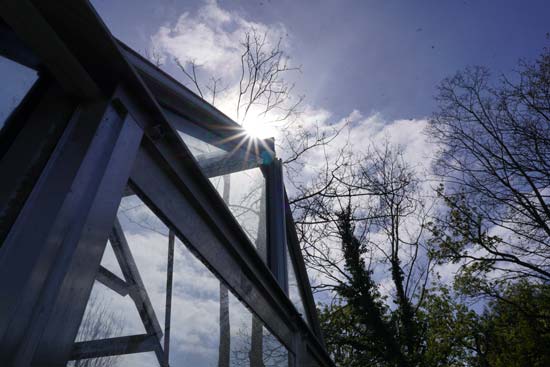
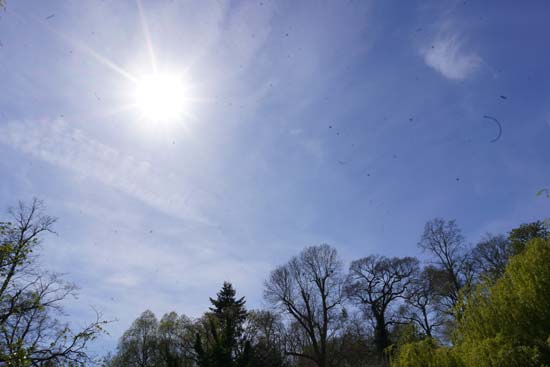
Macro
The Sony FE 24mm F2.8 G is not really a macro lens, offering a close minimum focusing distance of 18cm when manually focusing and 24cm when auto-focusing, and a maximum magnification of 0.19x in MF and 0.13x in AF. The following examples demonstrate how close you can get to your subject.



Bokeh
Bokeh is a word used for the out-of-focus areas of a photograph, and is usually described in qualitative terms, such as smooth / creamy / harsh etc.
In the FE 24mm F1.8 lens, Sony have employed an iris diaphragm with 7 rounded blades, which has resulted in quite appealing bokeh for what is after all a wide-angle lens.
We do realise, however, that bokeh evaluation is subjective, so we’ve included several examples below for your perusal, all shot wide-open at f/2.8.

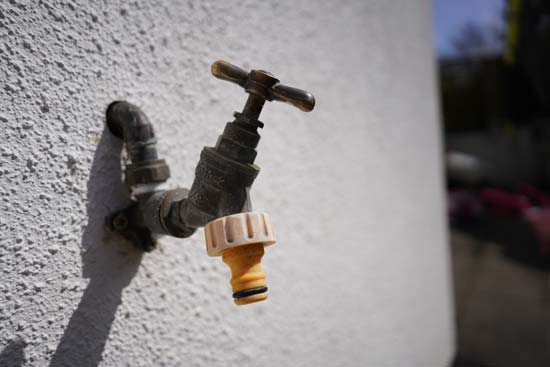






Sharpness
In order to show you how sharp the Sony FE 24mm F2.8 G lens is, we are providing 100% crops on the following page.


